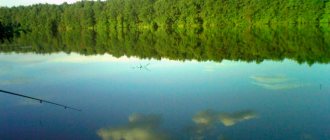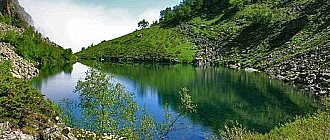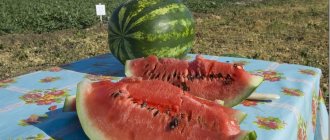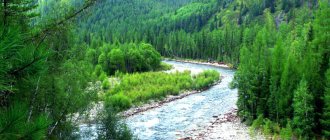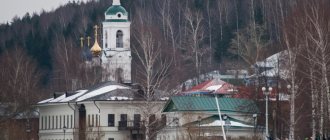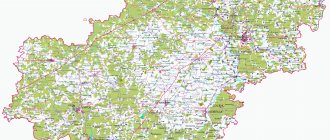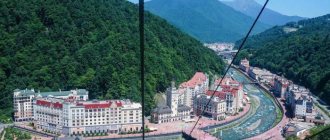| Unfinished article about the Russian region This article about the Russian region is in the process of being written. It requires significant revision and/or may have major flaws in design and content. You can help the project and finish it. |
Republic of Tuva
on the map of Russia
Republic of Tuva
(Tuva Republic),
Tuva
is a region within the Siberian Federal District of Russia, the capital is Kyzyl (Tuva. Kyzyl) (population 176,212) at the confluence of the Big Yenisei and Small Yenisei rivers into the Upper Yenisei. Territory - 168,604 km², population - 327,383 (as of January 1, 2020). Chairman of the Government of the Republic of Tyva - Sholban Valerievich Kara-ool (since April 6, 2007).
What holiday is it today?
December 17, 2021, Friday
Today are holidays, events: Day of Strategic Missile Forces Day of State Courier Service Employees Memorable date in the military history of Russia: Capture of the Ochakov fortress in 1788 Tomorrow: Day of the internal security units of the internal affairs bodies of the Russian Federation (FSB) Day of civil registry office workers International Immigrant Day
Today is an Orthodox holiday : Great Martyr Barbara and Martyr Juliania of Iliopolis. St. John of Damascus... Tomorrow: St. Sava the Sanctified. Saint Gury, Archbishop of Kazan...
Today is a national holiday: Varvarin Day... Tomorrow: Savvin Day...
Content
- 1 Cities of Tuva
- 2 Economy of the region 2.1 Major projects
- 2.2 News about the development of the region
- 2.3 Enterprises of the region 2.3.1 Enterprises of the mechanical engineering industry
- 2.3.2 Enterprises of the fuel and energy complex
- 2.3.3 Enterprises of the chemical complex
- 2.3.4 Metal processing plants
- 2.3.5 Light and textile industry enterprises
- 2.3.6 Enterprises of the timber industry complex
- 2.3.7 Construction industry enterprises
- 2.3.8 Enterprises of the agro-industrial complex
- 2.3.9 Food industry enterprises
- 2.3.10 Folk arts and crafts enterprises
- 2.3.11 Extractive industry enterprises
- 2.3.12 Other enterprises
Seasons
Seasons, four periods of the year (spring, summer, autumn and winter) characterized by certain average temperatures. The period during which the Sun passes through one of these sectors is called the season. Spring in the Northern Hemisphere and autumn in the Southern Hemisphere begin when the Sun passes through the initial circle of declination and its right ascension is 0° (vernal equinox). Summer in the Northern Hemisphere and winter in the Southern Hemisphere occur when the sun's right ascension is 90° (summer solstice). Autumn in the Northern Hemisphere and spring in the Southern Hemisphere begin when the sun's right ascension is 180° (autumnal equinox). The beginning of winter in the Northern Hemisphere and summer in the Southern Hemisphere is considered to be the winter solstice, when the direct ascension of the Sun is 270°... Next: Seasons. Russian folk calendar. Monthly words...
Folk calendar about every day
Every day one season always replaces another and this determines a person’s way of life. In connection with this, a folk calendar was formed in which there were practically no nameless, unmarked days. Every day was special, had its own purpose. All this was determined by climate conditions and astrological phenomena.
A calendar is a system for counting periods of time. The first calendars arose a long time ago, in ancient times, because there was a need to measure time. The word calendar comes from the Latin words caleo - to proclaim and calendarium - debt book. This is due to the fact that in Ancient Rome the beginning of each month was especially proclaimed, and because it was customary to pay debts on the first day of the month. Different peoples counted time differently. Some calendars are based on the changing phases of the moon - lunar calendars; in others - the change of seasons - sunny; in others, the length of the year was coordinated with the change of seasons, and the counting of months was associated with the phases of the Moon. Such calendars are called lunisolar.
In Rus', the calendar was called a monthly calendar. Every day, the month book covered the entire year of peasant life, “describing” day by day, month after month, where each day had its own holidays or weekdays, customs and superstitions, traditions and rituals, natural signs and phenomena. The cyclical nature of the calendar is reminiscent of human life, where spring is youth, summer is heyday, autumn is the time of harvesting fruits (it’s good if there are some, otherwise you can live your life without collecting fruits), winter is the time of wisdom and peace. This cyclicality and rhythm determined the way of life of the farmer. The folk calendar was an agricultural calendar, which was reflected in the names of the months, folk signs, rituals and customs. Even the determination of the timing and duration of the seasons is associated with real climatic conditions. Hence the discrepancy between the names of the months in different areas... Next: Folk calendar...
Fishing calendar for every day
The fishing calendar should not be taken as an absolutely indisputable truth. Fish biting is greatly influenced by a whole range of natural factors, as well as the influence on the nature of man himself. You must not forget that the fish’s bite depends and is determined not only by the calendar dates and biological cycles of their life, reflected in the calendar, but also, no less, by the state of their habitat; the bite also depends on weather conditions: air and water temperatures, cloudiness, wind direction and strength, etc... Next: Fishing calendar...
Geographical location of the Republic of Tyva
The republic has a common border with Mongolia. Its length is 1371.2 km. Within the country, Tuva borders on the Altai Republic, Buryatia, Khakassia, Irkutsk Region and Krasnoyarsk Territory. Geographically, the entire territory of Tyva is located in the Western Sayan region. Almost 80% of its landscapes are mountains. Snow-capped mountains and glaciers coexist with tundra and taiga in this region. There are also zones of steppes and semi-steppes in the republic.
The satellite map of Tyva shows about 6,700 large and small lakes. Their total surface area is more than 109 thousand hectares. The main part of the reservoirs is located in the Todzha Basin. The largest republics:
- Chagytay;
- Azas;
- Sut-Khol;
- Cora-Hol.
The main river of Tyva is the Yenisei. The republic's reservoirs contain fish: grayling, lenok, taimen, ide, pike, whitefish and others.
Orthodox calendar about every day
Orthodox calendar: Orthodox, Church and Christian holidays.
The church year is an alternation of weekdays and holidays. On weekdays, a person is called to work “by the sweat of his brow to earn his bread.” Holidays are given in order to feel liberation, to rise above the bustle and routine of the world, to feel involved in the highest of worlds, “where there are no illnesses, sorrows and sighs, but endless life.” Since ancient times, holiday cycles have been associated with the seasons. The pagans associated them with the worship of the forces of nature, the cult of which in the Old Testament was replaced by gratitude to the Creator for the universe. And although the connection between holidays and the seasons has not completely lost its power, since God is present in everything, in the plant and animal world, in human works, it nevertheless faded into the background, giving way to a spiritual foundation built on the Sacred Scriptures. The history of Orthodox holidays dates back to the times of the Old Testament. Each of the Orthodox holidays is dedicated to the remembrance of the most important events in the life of Jesus Christ and the Mother of God, as well as the memory of saints... Next: Orthodox calendar...
Russian folk calendar for every day
The word “sign” comes from the word “notice”, i.e. observe. As a result of observing what happens around a person every day, he accumulates life experience. This knowledge was passed down from generation to generation, carefully preserved and people trusted it as a sacred book. Many signs have come to us from the depths of centuries without losing their knowledge. Each of us is free to choose: to dismiss all this as an absurd superstition or to take a closer look at the signs and take the centuries-old experience of generations more seriously. Most of us, when taking exams, ask them to scold them, boasting about some kind of good fortune or luck, spit so as not to jinx them or knock on wood, take a detour if a black cat crossed the road, are afraid of the number 13 and much more. And who among us does not have lucky things, numbers? Who has never resorted to the help of fate at least once in their life, who has not believed in secrets? It’s as if everything connected with signs is hidden somewhere deep in our subconscious. Often we remember them mechanically, unconsciously, or just as a joke. But, undoubtedly, the signs contain a lot of accurate knowledge and practical wisdom of our ancestors. They cover all the characteristic, often difficult to perceive, natural phenomena. Signs have preserved a lot of what was in old folk holidays and customs; they help predict the weather, grow crops... Next: Folk signs...
General information about the Republic of Tuva
Distinctive features . The Republic of Tyva is the official name. In Russian it is more often called the Republic of Tuva or the Tuvan Republic. It is located in the heart of Asia. Indeed, the geographic center of Asia is located just 20 km from the city of Kyzyl, the capital of the republic.
On the road with clouds... we go to the Republic of Tuva
The uniqueness of the Republic of Tuva lies in the fact that, due to its long isolation from the outside world, the traditional way of life and way of life of nomadic Asian peoples has been preserved here. In addition, Tuva is one of the few republics in Russia where Buddhism is practiced.
The main riches of Tuva are its nature and minerals. Tuva is located at the junction of the Siberian taiga landscapes and the semi-deserts of Central Asia. This explains the diversity of local flora and fauna, which still requires protection at the state level. The Republic of Tuva has two nature reserves and 16 game reserves. The Ubsunur Basin Nature Reserve, which is a UNESCO natural heritage site, is especially important. Here you can find such a rare animal as the snow leopard, listed in the Red Book.
Irbis - snow leopard
Tuva has an extremely low investment rating and ranks 81st in terms of investment potential. The republic's economy is focused on mining and agriculture, mainly livestock farming. For local residents, nomads by nature, cattle breeding, goats, sheep and horses are a traditional activity, imbibed with mother's milk. As for industry, it is represented by mining, food, forestry and wood processing.
Tourism is another priority industry in the region. In addition to the majestic nature, taiga romance and unique Tuvan culture, there are more than 50 healing mineral springs. And even the President of Russia spoke highly of fishing in the Khemchik River (a tributary of the Yenisei), recommending it in an interview for the American magazine “OutdoorLife”.
The Republic of Tyva is one of the president’s favorite vacation spots
As for other high-ranking officials, one cannot help but recall the former head of the Ministry of Emergency Situations and the current Minister of Defense, President of the Russian Geographical Society Sergei Shoigu, who was born in these parts, in the small town of Chadan. They say that he is doubly strict with local officials.
Geographical location . The Republic of Tuva is located in the south of Siberia, on the border with Mongolia. It is part of the Siberian Federal District. Its neighbors are: the Republic of Altai, the Republic of Khakassia, the Krasnoyarsk Territory, the Irkutsk Region and the Republic of Buryatia.
Almost the entire territory of the republic is an earthquake-prone zone covered with mountains. In the north are the Western Sayans, with an altitude of 2 - 3 km above sea level. In the west there is a higher mountain range - Altai. These mountains inspire respect: 3976 m - Mongun-Taiga, 3608 m - Ak-Oyuk.
Thus, Tuva looks like a huge bowl, surrounded on all sides by mountain ranges, and in its center there is a large valley through which one of the largest rivers in Siberia, the Yenisei, flows. Here are the headwaters of this great river, and it is here that the Big Yenisei and Small Yenisei merge into one big river. There are also 6,700 lakes, 70% of which are concentrated in the Todzha Basin.
The Khemchik River is a tributary of the Yenisei
Population. The Republic of Tuva has a population of 310,460 people. 53.92% of them live in cities. There is a very low average life expectancy here - only 57-60 years. This is partly due to the fact that the indigenous population, the Tuvans, lead a traditional nomadic lifestyle, engage in cattle breeding and experience a shortage of both healthy fruits and normal medical care.
82% of the inhabitants are Tuvans, 16.3% are Russians. In addition to them, representatives of a variety of national groups live in the republic, including Khakass, Buryats, Kyrgyz, etc. The exotic culture of the Tuvans attracts tourists from all over Russia. Many people are interested in watching local dances, listening to Tuvan throat singing, or watching wrestling or horseback riding competitions. Festivals are held especially for this in Tuva.
Tuvan religion is a mixture of Buddhism and shamanism
Crime . The Republic of Tuva has a high crime rate. In the ranking of regions by the number of crimes per 1000 inhabitants, it ranks 38th. Among the most typical crimes are murders due to drunkenness, as well as the disappearance of tourists traveling around the republic. But it should be noted that in neighboring regions the crime rate is much higher. This is a dubious consolation, but let the Tuvans be pleased.
The unemployment rate in the Republic of Tuva is one of the highest in Russia - 18.38%. And it’s not that local residents are lazy, there’s just a catastrophic lack of jobs. Due to the low investment rating, investors are in no hurry to invest their money here. The average salary in the republic is 22 thousand rubles. But in some industries wages are much higher. For example, in the field of financial activities - 63 thousand rubles, for the military and border guards - 43 thousand rubles, in the field of mining - 40 thousand rubles.
The cost of real estate in Kyzyl, the capital of the republic, is approximately 45 thousand rubles. per sq. m. Prices for one-room apartments start from 800 - 900 thousand rubles and reach 1.5 million rubles. Prices for two-room apartments start from the same amount - 1.5 - 1.7 million rubles. However, housing in Tuva is in short supply, and there are very few offers.
The climate of the Republic of Tuva is sharply continental. In January there are severe frosts, on average 30-35 degrees below zero. In July the average temperature is about 20 degrees Celsius. There is little precipitation here - up to 400 mm per year. But in mountainous areas this value can reach 1000 mm.
Typical Tuvan landscape
Holiday calendar, dates and events of the year
All state and professional holidays in Russia, including significant World and International holidays, and other equally interesting holidays and events about every day.
The holiday has always kept pace with the history of mankind. Social time can be divided into three types: everyday life (weekdays), weekends and holidays. Everyday life is a series of practices repeated day after day and every day (work). Weekends are regular breaks from the rush of everyday life. It is believed that on weekends a person should restore his strength after working days. Day off, non-working day. A holiday is a day of celebration established in honor or in memory of someone or something. A day or series of days celebrated by the church in memory of a religious event or saint... Next: Calendar...
Prayer book, Orthodox prayers for every day
Prayer is the most powerful means for healing all illnesses - both physical and mental. Prayers can be laudatory or grateful, petitionary and repentant. If we have offended God, sinned, we must ask Him for forgiveness, that is, repent. Such prayers are called repentant prayers. If everything is fine with us, if we and our loved ones are healthy and prosperous, if we have a place to live, something to wear, something to eat, we must glorify and thank God for this. Such prayers are called praise or thanksgiving. If some misfortune, illness, trouble or need happens, you need to ask God for help. Such prayers are called petitionary... Next: Orthodox prayers...
Cities of the Republic of Tyva
Kyzyl (also known as Kyzyl-Orda) is the capital of the republic. Population - 113 thousand people. It was founded in 1914, receiving the name Belotsarsk. This city lies on a plain and has wide green streets. Despite the greenery and beautiful parks, the ecology of the city is a headache for local residents, largely thanks to the local thermal power plant, which pollutes the atmosphere with harmful compounds. A good infrastructure has been created here, including educational institutions, scientific institutes, museums, and sports complexes. But there are very few businesses here, and finding work is not so easy.
Ak-Dovurak (population - 13,548 people) - this city, founded in 1964, is interesting because, unlike most other settlements of the republic, there are at least some industrial enterprises here. The name of the city is translated as “white clay” because of the deposit of a rare type of asbestos located here, which can no longer be found in all of Russia. Accordingly, the city-forming enterprise here is Tuvaasbest. But the other side of the coin is the health threat from asbestos. And the Ak-Dovuratskaya Thermal Power Plant located here only aggravates the environmental problem.
Zodiac, astrological, eastern calendar. Zodiac signs
In ancient times, to establish the calendar, priests used knowledge of the positions of all the planets. Before the reform of Peter 1, the New Year was celebrated on the Day of the Autumn Equinox. On this day, according to ancient legend, the most peaceful treaty was concluded between the Great Race (ancient Slavs) and the Great Dragon (ancient Chinese) and it was approximately 7518 years ago... For the ancient Slavs, the calendar month corresponded to the lunar cycle from new moon to new moon, taking into account such Thus, the relationship of the entire annual cycle with astronomical and natural phenomena. There was no coherent calendar system. The main natural phenomena are still considered to this day to be the days of the solar equinox and solstice - the Slavic holidays Maslenitsa, Kupala, Ovsen and Kolyada. But during the time of Peter 1, all ancient Slavic calendars were abolished and a new Western European calendar from the Nativity of Christ (Julian calendar) was introduced, while the beginning of the calendar was moved to January 1. The Julian calendar (old style) did not take leap days into account and accumulated one extra day every 128 years. After the October Revolution in 1918, the Gregorian calendar (new style) was introduced in Russia, according to which an amendment of 13 days was introduced. The calendar of the ancient Slavs was based on two planets: the Sun and the Moon. And now they don’t use anything at all. The calendar has become static. There is no such thing as the calendar, it turns out, resting on some planet. Nobody even knows about it. There are just some standard numbers, there are months and holidays. The calendar is based on the Sun and Moon. Why is this so? Because these two luminaries influence the Earth. The Earth revolves around the Sun, and the Moon revolves around the Earth. And these two luminaries create the atmosphere on the planet. From here the calendar is built... Next: Astrological calendar...
Map of Tuva with cities, districts and villages
| 1. Kyzyl | 4. Toora-Khem village. (Todzhinsky district) | 7. Kaa-Khem rp (Kyzyl district) | 10. Chadan city (Dzun-Khemchik district) |
| 2. Turan city (Piy-Khemsky district) | 5. Erzin s. (Erzinsky district) | 8. Ak-Dovurak city | 11. Saryg-Sep village. (Kaa-Khem district) |
| 3. Samagaltai village. (Tes-Khem district) | 6. Khandagaity village. (Ovursky district) | 9. Kyzyl-Mazhalyk village. (Barun-Khemchik district) | 12. Mugur-Aksy village. (Mongun-Taiginsky district) |
Satellite map of the Republic of Tuva
Switching between the satellite map of Tyva and the schematic map is done in the lower left corner of the interactive map.
Republic of Tyva—Wikipedia:
Date of formation of the Republic of Tuva:
October 13, 1944
Population of Tyva:
330,368 people.
(January 1, 2021) Telephone code of Tyva:
394
Area of Tyva:
170,500 km²
Automobile code of Tuva:
17
Regions of the Republic of Tyva:
Bai-Taiginsky, Barun-Khemchiksky, Dzun-Khemchiksky, Kaa-Khemsky, Kyzylsky, Mongun-Taiginsky, Ovursky, Piy-Khemsky, Sut-Kholsky, Tandinsky, Tere-Kholsky, Tes-Khemsky, Todzhinsky, Ulug-Khemsky, Chaa- Kholsky, Chedi-Kholsky, Erzinsky.
Cities of Tyva - list of cities in alphabetical order:
Population of cities in Tyva in 2021.
Ak-Dovurak city
founded in 1964.
The population of the city is 13,578 people. The city of Kyzyl
was founded in 1914.
The population of the city is 116,015 people. The city of Turan
was founded in 1885.
The population of the city is 4922 people. The city of Chadan
was founded in 1873.
The population of the city is 8991 people. The city of Shagonar
was founded in 1888. The population of the city is 10973 people.
Tyva Republic
(or
Tuva
, as it is also often called) is located in the geographic center of Asia in southern Siberia, in the upper reaches of the Yenisei River, surrounded by the Sayan and Tannu-Ola mountain ranges.
The capital of this region is the city of Kyzyl
.
Tuva has a fascinating history and is unusual in that it only became part of the USSR in 1944, having previously existed as an independent state of the Tuvan People's Republic for more than two decades. In addition, the republic also has an interesting combination of Buddhism and shamanism, as well as a rich culture of Tuvan throat singing, oral folklore, khuresh wrestling and horse riding. Unlike many other Russian republics, the people of Tyva - Tuvans who speak the Turkic language - make up the majority of the republic's population - just over 80%.
Tyva borders Altai, Khakassia, Buryatia, Irkutsk region and Krasnoyarsk Territory, and also has a state border with Mongolia. The main transport routes are the bus route to Abakan in Khakassia and flights to Krasnoyarsk, Novosibirsk and Irkutsk. A project is being implemented to connect Kyzyl with the Krasnoyarsk Territory by railway.
Kyzyl city
The capital of Tyva, the city of Kyzyl, was founded in 1914. Then it was known as Belotsarsk and was part of the protectorate of the Russian Empire. After the revolution, it changed its imperial name to Khem-Beldir (“River Tributary”) due to its location at the confluence of the Big and Small tributaries of the Yenisei.
The city then received its current name, which means “Red” in Tuvan, a few years later when it was the capital of the independent Tuvan People's Republic. After Tuva/Tuva became part of Russia in 1944, Kyzyl became the capital of the Tuva Autonomous Soviet Socialist Republic and then the Tyva Republic of the Russian Federation.
What to see in the Republic of Tyva
Tyva's main attractions include its capital, Kyzyl, the geographic center of Asia; the city of Chadan, the birthplace of Russian politician Sergei Shoigu and home to an important Buddhist monastery; ethnocultural complex Aldyn-Bulak, various lakes, including salty Dus-Khol; the Old Believer settlement of Erzhey and many other stunningly beautiful natural attractions in this country of mountains, rivers, tundra, lakes, steppe and taiga.
The sights of Tyva differ from other typical monuments in Russia, since Asia has had a great influence on the republic. One of the most popular places among tourists is the Valley of the Kings.
. This is an area with a large number of mounds that serve as tombs for Scythian tribes. The order of the burial mounds indicates the family ties of those buried.
One of the natural monuments of Tyva is of international importance, occupying one of the places on the UNESCO list. This is the Ubsunur Basin National Park and Nature Reserve. Uvsu-Nur is a unique and largest lake in this reserve. On its banks, archaeologists have discovered traces of the habitation of ancient people: burials, household items and inscriptions.
Dream books online, interpretation of dreams
A dream book is nothing more than an interpreter of dreams and dreams, a translator of dreams. Since ancient times, people have been using dream books; dreams have always been given great importance, and people have often noticed the prophetic properties of some dreams. The dream book can become your faithful assistant every day and throughout your life, thanks to the dream interpreter you can always make the right decisions, the dream book will help you resist temptations in time, and will warn you against wrong steps and frivolous actions. Further…
